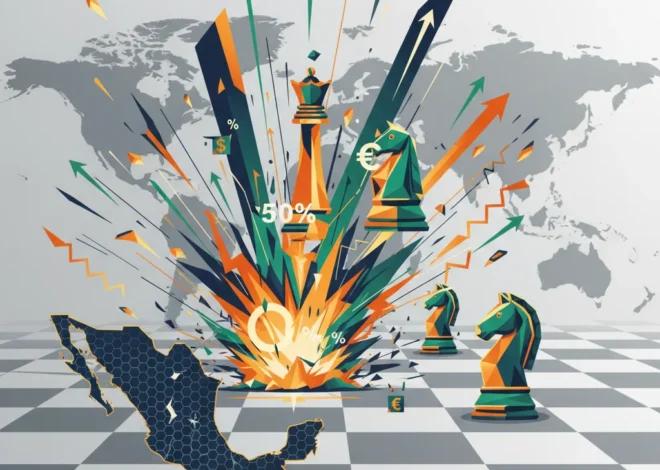
Nikkei Shatters 50,000: Decoding the Global Market Surge on US-China Trade Hopes
The global financial world held its collective breath today as markets surged with a vigor not seen in years. At the heart of this explosive rally is a powerful wave of optimism surrounding the seemingly intractable US-China trade dispute. The most dramatic headline comes from Asia, where Japan’s Nikkei 225 index spectacularly breached the 50,000-point mark for the first time in over three decades, a psychologically massive milestone for the nation’s economy. According to reports, this market euphoria coincides with a high-stakes diplomatic mission, as former US President Donald Trump heads to Tokyo for a pivotal meeting with Japanese Prime Minister Sanae Takaichi (source).
This isn’t just another fleeting rally; it’s a potential paradigm shift. For years, investors and business leaders have navigated a landscape defined by tariffs, sanctions, and supply chain disruptions. The mere whisper of a détente between the world’s two largest economies is enough to send shockwaves through every asset class. In this analysis, we will dissect the drivers behind this rally, explore the profound significance of the Nikkei’s achievement, and analyze the geopolitical chess match unfolding in Tokyo. What does this mean for the future of investing, global finance, and the intricate dance of international economics?
The Anatomy of a Global Rally
The positive sentiment was not confined to Japan. Equity markets across the globe lit up in a sea of green, reflecting a synchronized response to the potential thawing of trade relations. This broad-based rally underscores how deeply interconnected the global stock market has become, with fortunes in Frankfurt and New York being directly influenced by diplomatic whispers in Beijing and Washington.
Here is a snapshot of how major global indices reacted to the news:
| Index | Region | Movement | Key Drivers |
|---|---|---|---|
| Nikkei 225 (Japan) | Asia | +4.5% (Breached 50,000) | Heavy exposure to export-oriented tech and auto sectors; relief from supply chain pressures. |
| S&P 500 (USA) | North America | +2.8% | Gains in semiconductor, industrial, and agricultural stocks directly impacted by China tariffs. |
| Shanghai Composite (China) | Asia | +3.1% | Renewed hope for domestic tech giants and manufacturing exporters. |
| DAX (Germany) | Europe | +2.5% | Boost for major automobile and machinery exporters who rely on both US and Chinese markets. |
The data clearly shows a global sigh of relief. Companies that have spent the better part of a decade diversifying supply chains and absorbing tariff costs are now seeing a potential light at the end of the tunnel. This has profound implications not just for equity trading but for corporate capital expenditure, hiring, and overall economic growth projections for the next several years.
Bolivia at a Crossroads: Can a New Centrist President Solve a Deepening Economic Crisis?
Behind the Optimism: What’s on the US-China Negotiating Table?
While official details remain scarce, market intelligence suggests that negotiators are making headway on a “Phase Two” trade agreement that addresses the core, structural issues that the initial deals sidestepped. The optimism appears rooted in progress on three critical fronts:
- Intellectual Property (IP) and Technology Transfer: This has been the thorniest issue. The new framework reportedly includes robust, verifiable enforcement mechanisms to protect American IP, a long-standing demand from Washington. For China, it may involve clearer, internationally recognized pathways for technology licensing, moving away from forced transfers.
- Agricultural Purchases: The agreement is expected to include multi-year, large-scale commitments from China to purchase US agricultural products like soybeans, corn, and pork. This provides a much-needed lifeline to the American heartland and helps Beijing ensure food security.
- Market Access for Financial Services: There is growing speculation that Beijing is prepared to further open its massive domestic market to American banking and investment firms. This could be a game-changer for Wall Street and a significant step in liberalizing China’s capital accounts.
A breakthrough on these fronts would do more than just roll back tariffs; it would fundamentally reset the terms of trade, creating a more predictable and stable environment for international business. The impact on the financial technology sector could be particularly significant, as smoother cross-border data flows and investment would accelerate innovation.
Japan’s Economic Dawn: The Deeper Meaning of Nikkei 50,000
For Japan, the Nikkei breaching 50,000 is more than just a number; it’s a symbolic exorcism of the “Lost Decades” that followed the collapse of its asset bubble in the early 1990s. The index’s previous peak stood for over 30 years as a monument to economic stagnation. Today’s milestone, as reported by sources covering the global rally like the Financial Times, is built on a different foundation.
This new peak is supported by tangible changes in the Japanese economy:
- Corporate Governance Reforms: A concerted push by regulators has forced Japanese companies to become more shareholder-friendly, unlocking value through buybacks and higher dividends.
- An End to Deflation: After decades of falling prices, Japan is finally experiencing modest, sustained inflation, which encourages spending and investment.
- Global Supply Chain Linchpin: Japanese companies are indispensable in high-tech global supply chains, particularly in semiconductors, robotics, and specialized components. A US-China truce directly benefits these export powerhouses.
The Trump-Takaichi meeting in Tokyo is therefore critically important. Prime Minister Takaichi, known for her strong nationalist and pro-business stance, will be keen to secure Japan’s position in any new US-China framework. Discussions will likely focus on currency stability (preventing the yen from strengthening too rapidly and hurting exporters), technological cooperation, and ensuring Japanese firms are not disadvantaged in the redrawn global trade map.
Silence in the Halls of Power: ECB Faces Unprecedented Lawsuit Over Free Speech
The Future of Trade Finance: A Role for Blockchain?
As we look beyond the immediate market reaction, this potential trade resolution opens the door for technological evolution in how global trade is conducted. The disputes of the past decade have exposed the fragility and inefficiency of traditional trade finance systems, which still rely heavily on paperwork and manual verification.
This is where emerging financial technology, particularly blockchain, could play a transformative role. A distributed ledger could create an immutable, transparent record of a product’s journey from factory to consumer. Consider the benefits in the context of a new US-China trade deal:
- Verifiability: A blockchain-based system could instantly verify the origin of goods, ensuring compliance with tariff rules and preventing circumvention.
- Efficiency: Smart contracts could automate payments upon fulfillment of contract terms (e.g., when a shipment of soybeans arrives at a port), drastically reducing delays and the need for intermediaries in the banking system.
- Trust: In a relationship historically marked by distrust, a shared, unchangeable ledger provides a “single source of truth” for both regulators and commercial partners.
While mainstream adoption is still on the horizon, a landmark trade agreement could be the catalyst needed to standardize and implement these fintech solutions, building a more resilient and transparent global trading architecture for the 21st century.
Conclusion: A New Chapter for the Global Economy?
Today’s global stock market rally, spearheaded by the Nikkei’s historic achievement (source), is a powerful vote of confidence in diplomacy and economic pragmatism. The prospect of a comprehensive US-China trade agreement has unleashed a torrent of optimism, promising to lower inflation, stabilize supply chains, and foster a more predictable environment for investing and growth.
However, the path forward remains fraught with challenges. Geopolitical tensions, domestic political pressures, and the sheer complexity of the global economy mean that volatility is never far away. For investors and business leaders, the message is one of cautious optimism. The current environment presents significant opportunities, but it also demands a deep understanding of the intricate interplay between politics, economics, and technology. The world is watching the negotiations, hoping this is not just a temporary market high, but the genuine beginning of a new, more prosperous chapter in global relations.
China's High-Tech Gambit: Decoding the New 5-Year Plan for a Global Economy in Flux


